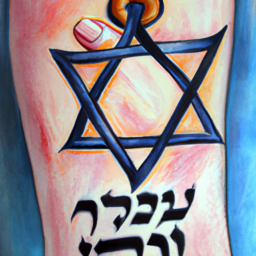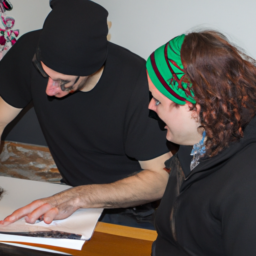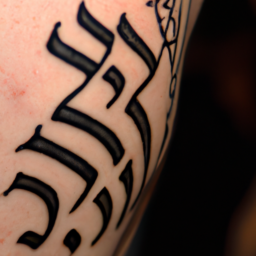“The Significance of Hebrew Calligraphy in Modern Tattoos”
Introduction to Hebrew Calligraphy and Modern Tattoos
Hebrew calligraphy, with its ancient roots and intricate letter forms, has long been a revered art form. Its history is deeply intertwined with the Jewish culture and religion, where the precise transcription of sacred texts was considered a holy task. The Hebrew script, known for its flowing lines and distinctive characters, has evolved over centuries, yet it retains a timeless elegance that continues to captivate both practitioners and admirers.
In recent years, the incorporation of calligraphy into modern tattoo art has seen a surge in popularity. This fusion of ancient script with contemporary body art has given rise to a unique aesthetic that appeals to a diverse audience. Tattoos, once marginalized, have gained widespread acceptance in contemporary society, becoming a canvas for personal expression and cultural identity.
The cultural and personal significance of tattoos cannot be overstated. For many, they are more than mere decorations; they are profound statements of one’s beliefs, experiences, and heritage. Hebrew calligraphy tattoos, in particular, carry a weight that transcends their visual appeal, often symbolizing a deep connection to one’s roots or a commitment to spiritual ideals.
The Aesthetic Appeal of Hebrew Script
The allure of Hebrew script lies in its unique visual elements. Each character is not just a letter but a work of art, with the potential to convey profound meaning and beauty. The Hebrew alphabet, with its absence of vowels and its right-to-left orientation, offers a distinct look that stands out among other scripts. This uniqueness is further enhanced by the traditional calligraphy that has been passed down through generations, influencing modern tattoo designs with its elegance and historical significance.
Typography and font choice play a crucial role in the aesthetics of Hebrew calligraphy tattoos. The selection of a particular style—be it classical, modern, or a personalized variation—can dramatically alter the tattoo’s impact. Artists must possess a deep understanding of the script’s form and flow to create designs that are not only visually striking but also respectful of the script’s heritage.
Hebrew Calligraphy as a Cultural Connector
Hebrew calligraphy serves as a powerful cultural connector, linking individuals to the rich tapestry of Jewish history and tradition. For those within the Jewish community, a tattoo in Hebrew script can be a profound affirmation of identity, especially in a diaspora where maintaining cultural connections can be challenging. It can also act as a bridge for non-Jews who wish to honor the Hebrew language or connect with its cultural or religious significance.
Tattoos in Hebrew script can foster a sense of belonging and continuity, linking the wearer to an ancient tradition while allowing them to express their contemporary identity. This connection is not limited to religious texts; it can also encompass cultural symbols, historical figures, and proverbs that resonate with the individual’s personal journey.
In conclusion, the interplay between Hebrew calligraphy and modern tattoos represents a fascinating convergence of ancient art and contemporary self-expression. The aesthetic appeal of Hebrew script, with its distinctive characters and traditional influence, offers a unique canvas for personal and cultural narratives. As a cultural connector, Hebrew tattoos bridge the gap between past and present, serving as a testament to the enduring relevance of the Hebrew language and its script. Whether for spiritual, religious, or purely artistic reasons, the integration of Hebrew calligraphy into the world of tattoos continues to enchant and inspire, ensuring that this ancient form of writing will leave a lasting imprint on the skin and souls of those who choose to bear it.
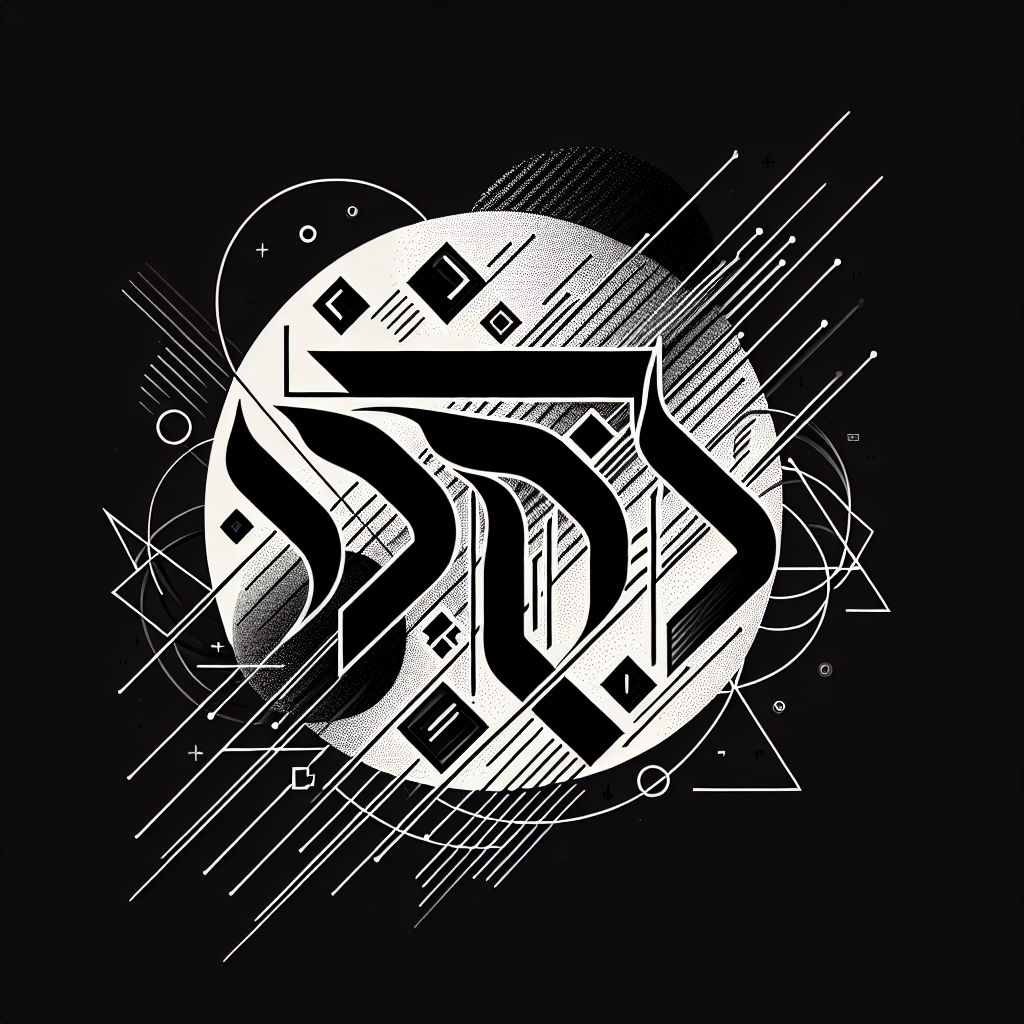
Spiritual and Religious Significance of Hebrew Calligraphy in Tattoos
In the realm of body art, Hebrew calligraphy holds a profound spiritual and religious significance that transcends mere aesthetics. The ancient script, with its storied past and sacred connotations, offers a tangible connection to the spiritual beliefs and religious practices of Judaism and, by extension, to the broader Judeo-Christian heritage.
The use of Hebrew calligraphy in tattoos often involves the inscription of religious texts, symbols, and names of divine significance. Verses from the Torah, Psalms, and other canonical texts are frequently chosen by individuals seeking to embody their faith or to carry a perpetual reminder of their spiritual foundations. The Shema Yisrael, one of the most important prayers in Judaism, and the Tetragrammaton, the four-letter biblical name of God, are among the most revered choices for tattoos, symbolizing a deep-rooted connection to the divine.
However, the intersection of tattoos and religious observance is not without controversy. Within many streams of Judaism, tattoos are traditionally forbidden based on interpretations of Levitical law, which prohibits body markings. This has led to ethical debates within religious communities, with some viewing the practice as a desecration of the body, while others adopt a more lenient stance, especially among the less orthodox and secular Jews. The conversation becomes even more nuanced when considering the historical trauma associated with forced tattoos during the Holocaust, which adds a layer of sensitivity to the subject.
Despite the debates, the prevalence of religious texts and symbols in Hebrew tattoos underscores a yearning for a tangible representation of personal faith. For some, these tattoos serve as a declaration of identity and belief, a permanent testament to their spiritual journey. For others, they are a form of protection, a talisman inscribed in the flesh to ward off evil and misfortune.
Personal Expression and Storytelling through Hebrew Calligraphy Tattoos
Tattoos, in their essence, are a form of personal narrative and self-expression. They are the stories people choose to tell on their skin, narratives that are as unique as the individuals bearing them. Hebrew calligraphy tattoos are particularly poignant in this regard, as they often symbolize personal milestones, experiences, and the intimate aspects of one’s life journey.
The storytelling aspect of tattoos can have a therapeutic potential, serving as a means to commemorate loved ones, mark significant life changes, or represent personal victories and challenges. The Hebrew script, with its inherent mystique and beauty, adds a layer of depth to these stories, allowing for a connection to a cultural and linguistic heritage that is thousands of years old.
For example, a person might choose to tattoo a Hebrew phrase that encapsulates a personal philosophy or a reminder of resilience in the face of adversity. Others might select a date of significance, such as the Hebrew date of a loved one’s passing, as a way to honor their memory. Each character, each stroke of the calligrapher’s pen, contributes to the narrative, making it a deeply personal emblem.
Hebrew Calligraphy as a Form of Artistic Expression
The art of Hebrew calligraphy in tattoos is not merely about the inscription of text; it is a craft that demands skill, precision, and a deep understanding of the script’s cultural and historical context. Tattoo artists specializing in Hebrew calligraphy must navigate the complexities of the language, ensuring that each letter is accurately depicted and that the text flows with the natural lines of the body.
The collaboration between tattoo artists and clients is a dance of creativity and meaning-making. It involves a mutual understanding of the symbolism behind the chosen script and a shared vision of how it should be represented on the skin. This partnership often results in a piece of art that is both visually stunning and rich in significance.
The recognition of tattooing as a legitimate art form has been a long time coming, with Hebrew calligraphy tattoos standing as a testament to the intricate beauty that can be achieved through ink and skin. These tattoos are not merely decorations but are expressions of identity, belief, and artistry that resonate on a profound level.
In conclusion, the spiritual and religious significance of Hebrew calligraphy tattoos, their role in personal expression and storytelling, and their status as a form of artistic expression, all contribute to the rich tapestry of modern body art. As individuals continue to seek out meaningful ways to represent their beliefs, experiences, and identities, the ancient script of Hebrew calligraphy will undoubtedly maintain its enduring impact in the world of tattoos.
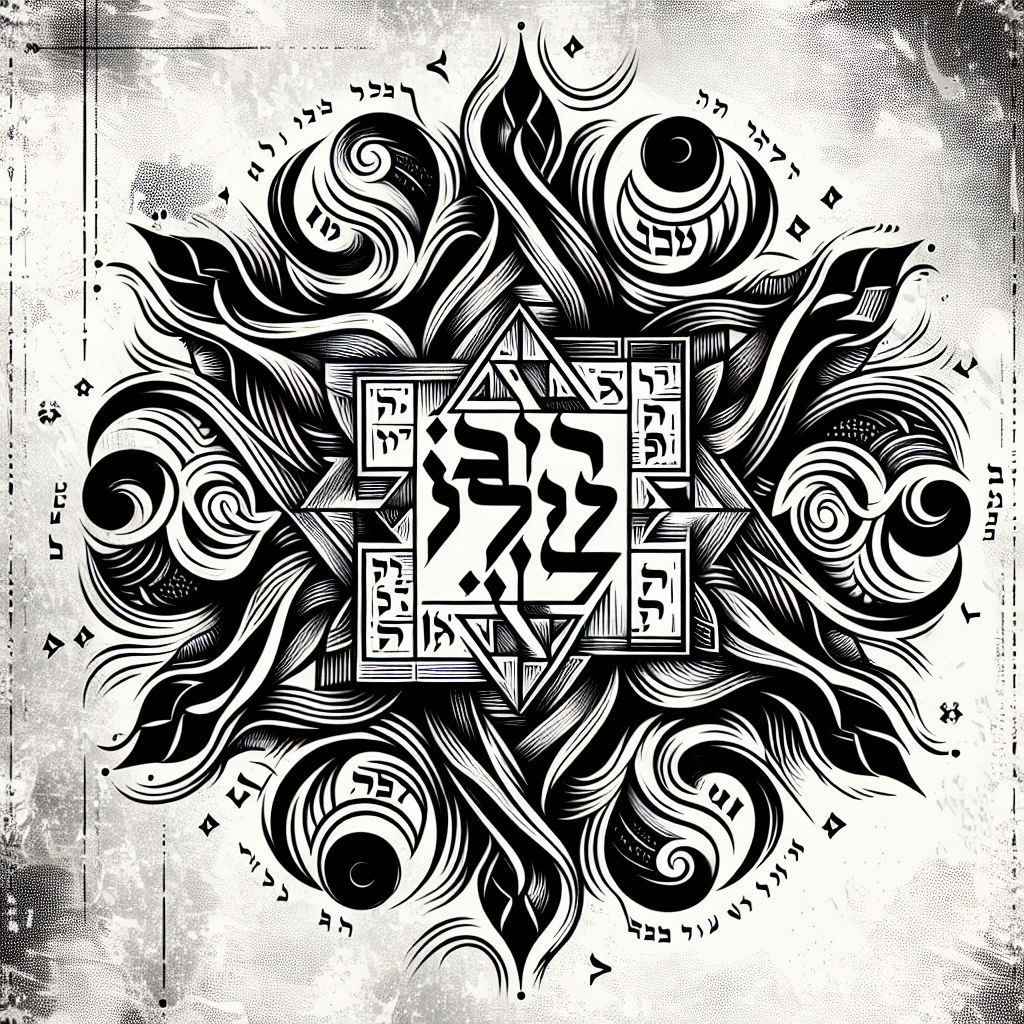
The Influence of Celebrity Culture on Hebrew Calligraphy Tattoos
In the realm of body art, the influence of celebrity culture cannot be overstated. Public figures and celebrities often set trends that ripple through society, and their choices can significantly impact the popularity and acceptance of certain tattoo designs, including those featuring Hebrew calligraphy. The allure of Hebrew script tattoos has been magnified by the visibility they’ve received through high-profile individuals who have chosen to inscribe their bodies with this ancient language.
The media exposure of celebrities with Hebrew calligraphy tattoos has contributed to a surge in interest among fans and the broader public. This fascination is not merely due to the aesthetic appeal of the script but also the desire to emulate the mystique and perceived depth associated with such tattoos. Celebrities often share personal stories behind their tattoos, which can resonate with their audience, leading to a deeper connection and a desire to express similar sentiments through their own body art.
However, the trendiness of Hebrew tattoos among celebrities can also lead to potential cultural appropriation. The sacredness of the Hebrew language to Jewish and Israeli cultures means that its use as a decorative element by those outside these communities can sometimes be seen as insensitive or disrespectful. It is crucial for individuals to understand the symbolism and meaning behind the characters they choose to tattoo on their bodies, especially when those symbols are rooted in a culture or religion not their own.
Preservation of Language and Heritage Through Tattoos
Tattoos in Hebrew calligraphy serve not only as a form of self-expression but also as a means of preserving language and heritage. For many, a tattoo in Hebrew script is a permanent declaration of their cultural identity and a tribute to their ancestral lineage. It is a way to keep the language alive and visible, especially for those in the diaspora who may feel disconnected from their cultural roots.
The act of inscribing one’s body with words or symbols in Hebrew can contribute to the passing down of traditions and the reinforcement of cultural bonds. It can also spark curiosity and encourage educational pursuits related to the Hebrew language and Jewish history. In this way, tattoos become more than just body art; they are educational tools that promote linguistic curiosity and cultural understanding.
Moreover, Hebrew calligraphy tattoos can serve as conversation starters, providing an opportunity for individuals to share their heritage with others. This exchange of cultural knowledge can foster a greater appreciation for the diversity of traditions and the beauty inherent in the Hebrew script.
Challenges and Controversies Surrounding Hebrew Calligraphy Tattoos
Despite their popularity and potential for cultural connection, Hebrew calligraphy tattoos are not without their challenges and controversies. One significant issue is the permanence of tattoos and how they are perceived in various cultures. In some religious communities, body modification, including tattoos, is frowned upon or outright forbidden. This can create a conflict for individuals who wish to express their faith or cultural identity through tattoos but are constrained by the tenets of their religion.
Misinterpretation and mistranslation are other common pitfalls. The Hebrew language has its own set of complexities, and without proper understanding, individuals may end up with tattoos that are incorrect or convey unintended meanings. This not only leads to personal embarrassment but can also be seen as disrespectful to the language and culture.
Cultural sensitivity is another critical consideration. The sacred texts and symbols of Judaism hold deep religious significance, and their use as decorative tattoos can be problematic. It is essential for individuals to approach the idea of a Hebrew tattoo with respect and to seek guidance from knowledgeable sources to ensure that their body art is appropriate and does not inadvertently offend.
In conclusion, Hebrew calligraphy tattoos are a profound way to connect with one’s heritage, express personal beliefs, and preserve a beautiful and ancient script. The influence of celebrities has undoubtedly played a role in popularizing these tattoos, but with this popularity comes the responsibility to approach the culture with respect and understanding. As tattoos continue to serve as a means of personal and cultural expression, it is vital to navigate the challenges and controversies with sensitivity and awareness. Only then can the enduring impact of Hebrew calligraphy in tattoos be fully appreciated and honored.
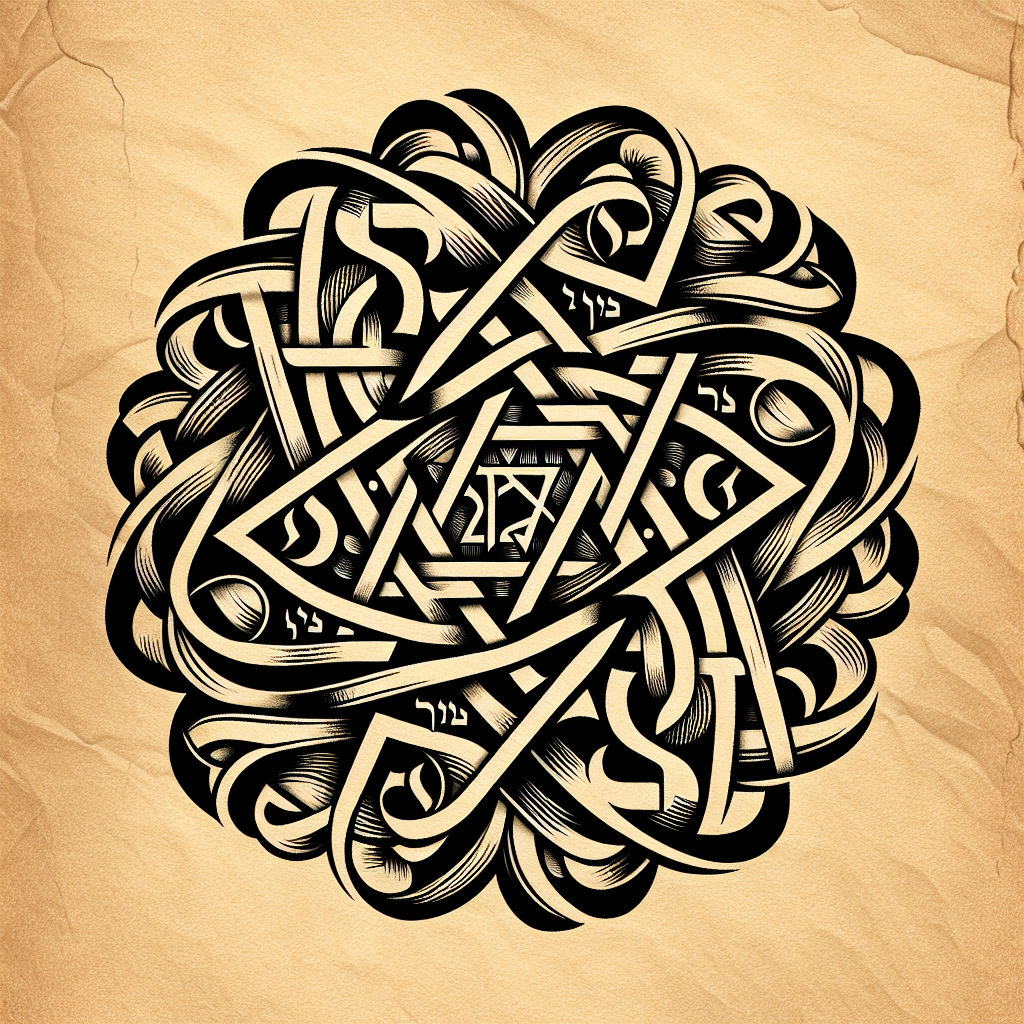
The Enduring Impact of Hebrew Calligraphy in Tattoos
In the intricate tapestry of modern body art, Hebrew calligraphy stands out as a thread that weaves together the ancient with the contemporary, the sacred with the personal. The practice of inscribing one’s skin with Hebrew script is more than a fleeting trend; it is a profound expression of identity, belief, and artistic appreciation that has secured a lasting impact in the tattoo industry.
Hebrew calligraphy, with its elegant strokes and profound historical roots, offers a unique aesthetic that resonates deeply with those who choose to bear it on their bodies. The script, which has carried the weight of religious texts and cultural narratives for millennia, now finds a new canvas on human skin. This transition from parchment to skin has not been without its challenges and controversies, but the significance of Hebrew tattoos remains undiminished.
The personal and collective meaning of adopting ancient script in contemporary body art is multifaceted. For some, Hebrew tattoos are a declaration of faith, a permanent reminder of spiritual beliefs and religious heritage. For others, they are a form of personal storytelling, a way to commemorate life’s milestones, or to pay tribute to loved ones. The script’s ability to encapsulate complex emotions and ideas in a single word or phrase makes it particularly suited to the intimate nature of tattoos.
The future of Hebrew calligraphy in the tattoo industry appears to be one of continued evolution. As tattooing becomes increasingly mainstream and accepted as a legitimate art form, the demand for skilled artists capable of rendering the script’s nuanced curves and lines grows. This demand not only promotes the craftsmanship involved in creating these tattoos but also encourages a deeper understanding of the script’s cultural and historical context.
However, the popularity of Hebrew tattoos is not without its challenges. The permanence of tattoos raises questions within cultures that have historically viewed body modification with skepticism. Moreover, the potential for misinterpretation and mistranslation of Hebrew text is a concern, as the language’s complexity can lead to unintended meanings being permanently etched onto skin. This underscores the importance of seeking knowledgeable artists and ensuring accurate translations before proceeding with a Hebrew tattoo.
Cultural sensitivity is another critical issue. As celebrities and public figures sport Hebrew calligraphy tattoos, the visibility and allure of these designs increase. While this can lead to greater appreciation of the script, it also raises the risk of cultural appropriation. It is crucial for individuals to approach Hebrew tattoos with respect for their sacred origins and to understand the symbolism behind the text they choose to display.
Despite these challenges, Hebrew calligraphy tattoos continue to serve as a powerful connector between individuals and their heritage. They play a role in preserving the Hebrew language and script, contributing to the cultural legacy that future generations will inherit. Moreover, they offer an educational aspect, sparking linguistic curiosity and encouraging cross-cultural dialogue.
In conclusion, the impact of Hebrew calligraphy in tattoos is enduring and significant. It transcends mere fashion, embodying a deep connection to history, spirituality, and personal identity. As the tattoo industry evolves, Hebrew calligraphy will undoubtedly remain a cherished choice for those seeking meaningful and beautiful body art. Its continued relevance is a testament to the script’s timeless appeal and the human desire to express the depths of our experiences through the art we carry on our bodies.
